Business owners pressured government officials to let them open back up…. Theater owners even descended on Mayor Mills’ office to demand he ease up on restrictions that were costing them $50,000 per week.
[Click any photo to enlarge.]
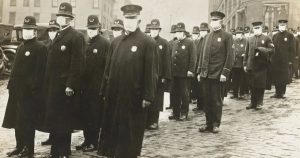
The mayor relented. On Nov. 11, Denver residents poured into the streets to celebrate Armistice Day — the end of World War I. Two weeks later, the city recorded 605 cases of Spanish flu and 22 deaths on a single day.
Restrictions had to be reimposed as public life once again ground to a halt. It wouldn’t be until January 1919 that the Spanish flu would finally run its course in Denver, though it lingered into the spring in outlying parts of the state.
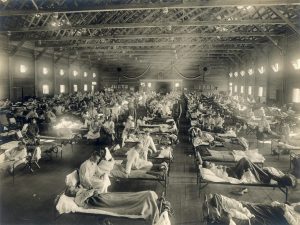
That’s a Bit from an Article in yesterday’s Denver Post, which noted the “Spanish flu” is thought to have actually originated just over the state line in Kansas. The 1918 flu was the worst pandemic of the modern era; let’s hope it continues to hold the record for a long time: as many as 100 million people died from it. About 27 percent of the world population (around half a billion of the about 1.9 billion at the time) got the virus; 100 million is 20 percent of the infected. Of course, those sobering numbers were from an era well before air travel.
But it Still Spread Quickly
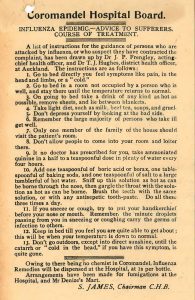
Newly inducted soldiers from that apparent origination point in Haskel County, Kan., traveled to Camp Funsten, now Fort Riley, in north central Kansas, and from there, it spread to the world as soldiers shipped out.
Kit liked this part, quoting someone from our immediate area:
Isaiah Knott, a health officer in the Uncompahgre Valley, chided his fellow residents in Montrose as cases mounted there. “If you are sick and do not stay away from social gatherings, you have the heart of a hun,” the Montrose Daily Press quoted him as saying on Oct. 8, 1918.
“Oooh! I love that slam,” Kit said. “‘The heart of a hun.’ 😂 ”
There are an awful lot of huns in the world today.
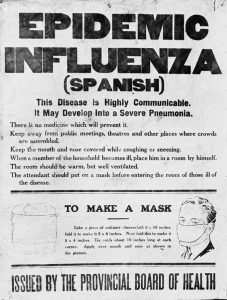
But What About…?
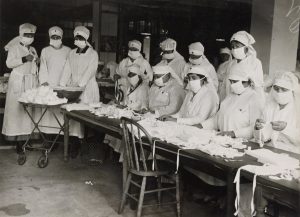
I had a laugh when I saw something along the lines of “eating lots of garlic will protect you against COVID-19!” My response: have you seen the numbers out of Italy? Please.
“Shelter in place” will probably last for months. Don’t get “tired” of it, like Denver did, leading to another surge in infections and death. Yep, the economics are going to be rough: we’re not officially in a recession yet, but there’s going to be one. With luck, it won’t last long.
The bottom line is, we need to listen to the people who have spent their lives studying stuff like this, and follow their suggestions.
And wash your hands!
—
I hope I don’t “really” need to tell you that COVID-19 is not an influenza virus, but rather a coronavirus, which is in a completely different class of virus. And yes, I’m definitely aware there is controversy over where the Spanish flu originated. It was likely not China, let alone Spain!
– – –
Bad link? Broken image? Other problem on this page? Use the Help button lower right, and thanks.
This page is an example of my style of “Thought-Provoking Entertainment”. This is True is an email newsletter that uses “weird news” as a vehicle to explore the human condition in an entertaining way. If that sounds good, click here to open a subscribe form.
To really support This is True, you’re invited to sign up for a subscription to the much-expanded “Premium” edition:
Q: Why would I want to pay more than the minimum rate?
A: To support the publication to help it thrive and stay online: this kind of support means less future need for price increases (and smaller increases when they do happen), which enables more people to upgrade. This option was requested by existing Premium subscribers.

As we watch people hoard toilet paper, paper towels and hand sanitizer (as I call it, the ‘pandemic trinity’), I have been wondering what long-term changes we will see. What changes will persist?
Clearly this list is subject to change, but a few preliminary thoughts, in no particular order of stickiness or importance, yet:
Sure there is more, but it will be interesting to see what sticks and what fades away….
—
I’m with you on all eight predictions. -rc
Another possible downside is that people will become more used to doing routine shopping — for food and such — online. I don’t know what high streets look like in the US, but here in the UK the number of proper shops has been falling for years, with increased numbers of Charity Shops (do you call them Thrift Shops, where cheaper second hand goods raise funds for good causes?). Many streets now are just these shops, bars or cafés, and empty units. The bright side of this is that perhaps these can be converted to living accommodation! The downside is that Amazon employs far fewer people in proportion to throughput than does a high street shop.
I think that if the changes you predict come to pass, it will actually be a good thing for the most part.
Good, unless your wages depend on working in a shop.
So how do we not have a “NEXT pandemic”? Masks. All the time. And gloves. Buy them by the gross, and wear them whenever you’re out in public. Be like the Dread Pirate Roberts:
Fezzik: “Why are you wearing a mask? Were you burned by acid or something?”
Westley: “No, it’s just they’re terribly comfortable. I think everyone will be wearing them in the future.”
https://www.youtube.com/watch?v=6inEWnnIlEk
9. Plexiglas shields at supermarket checkouts.
And at the garden checkout register at Lowe’s Home Improvement.
—
I stopped at the post office today since I had packages. There was a plastic curtain across the entire service counter, from the ceiling to a foot below its surface. (Our P.O. only has two windows.) There were 2 each holes cut for the credit card machines, and pretty small ones to pass mail back and forth. She had to pull the curtain to the side to pass one huge box through. -rc
Sorry to be a stickler, but 1918 was not “an era well before air travel.” The first regularly scheduled flights were in 1914, and KLM and Avianca were founded in 1919. (Pan Am was in 1925.) Numbers weren’t very large, of course.
—
Well, 1919 is still after 1918. I still don’t think there was much in the way of intercontinental flights in 1918, considering the first transatlantic flight wasn’t until June 14, 1919, from St. John’s, Newfoundland to Ireland (Lindbergh’s solo NY-Paris flight wasn’t until 1927). Yes, 1914 is before 1918, but tiny hops in tiny planes between nearby cities isn’t the sort of the “air travel era” I was referring to, where thousands of people a day move from continent to continent. -rc
“Huns” was the World-War-I epithet used by the Allies to describe the Germans. So saying someone has “the heart of a Hun” is equivalent to calling them an enemy sympathizer, a pretty strong accusation.
Please don’t put our modern sensitivities onto a historical quote. And if you look at the history of the Huns (Attila et al), and the Germans in WW1 you will see that they were murderous bunches rather like the then-called Spanish flu.
—
If I understood Andy’s comment correctly, he was referring to how the terms would play during WWI, not looking back and applying today’s sensibilities. Today, few have any idea of what the Huns were about; I didn’t until way into adulthood when I read about them. -rc
I’m not applying modern sensitivities. If someone in England or America used the term “Hun” in 1918, they would have been talking about Germans, not Attila’s horde. And it would not been complimentary. Anti-German sentiment was strong at the time, and expressing sympathy for the Germans was regarded as near-traitorous.
—
I’d actually think you’d need to remove the “near-” from that last phrase. As in WWII, Germany was on the wrong side of WWI. -rc/